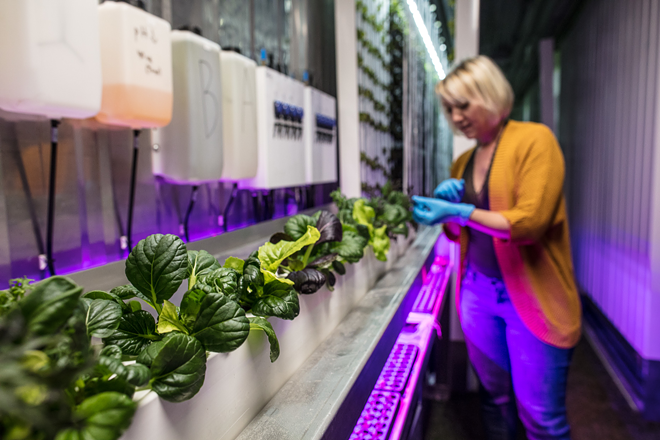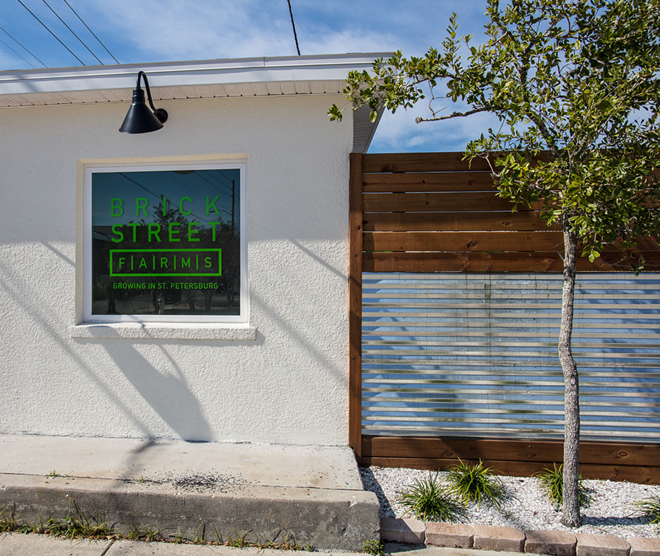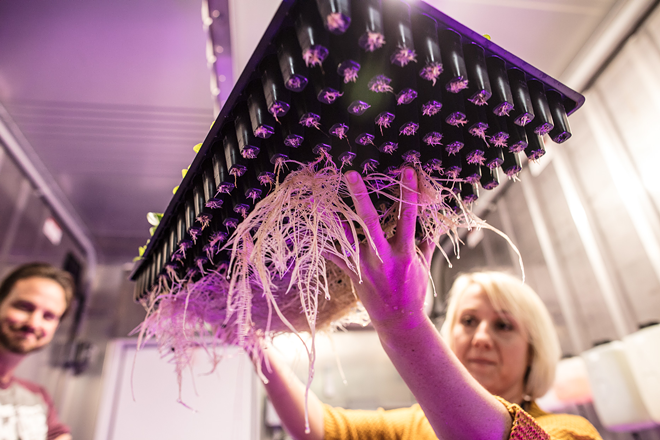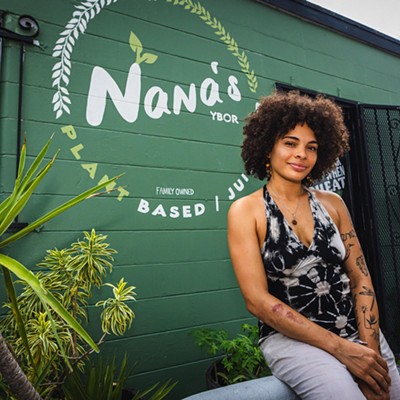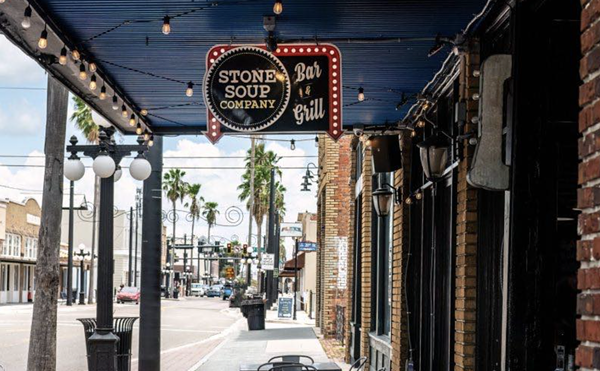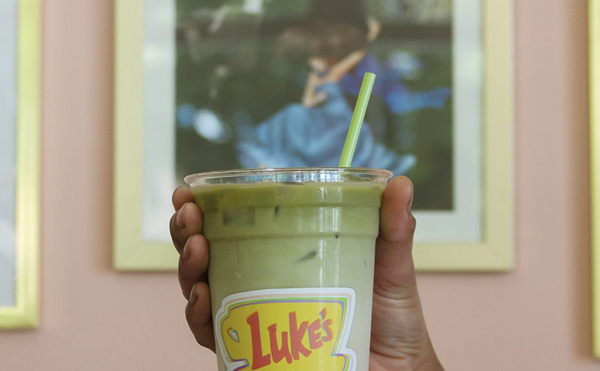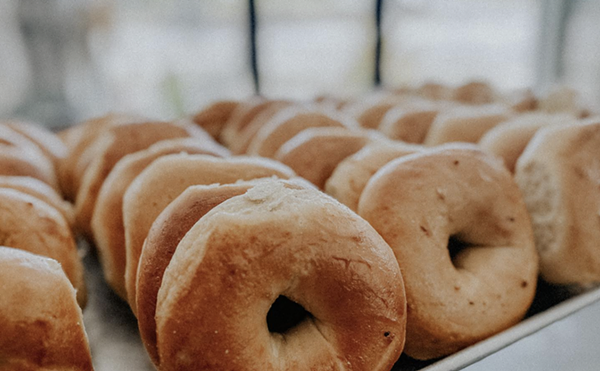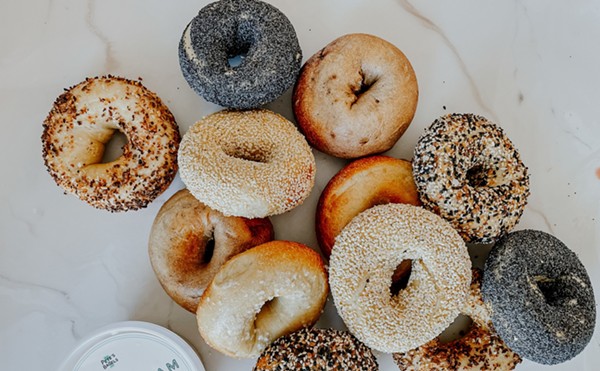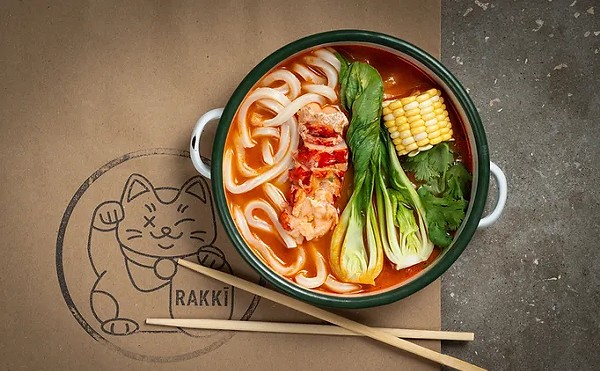Ever seen a farm with high-tech software or LED lighting? If not, pay a visit to Brick Street Farms.
The indoor hydroponic farm, owned by wife-and-husband duo Shannon O'Malley and Bradley Doyle, doesn't look like much from the outside. But spread out over green upcycled freight containers, planted inside a wooden fence that surrounds the former site of an abandoned junkyard at 2001 Second Ave. S., Brick Street has spent close to a year quietly blossoming in St. Petersburg.
What makes up this city farm's local, vertically grown bounty? Herbs and leafy greens.
"We started harvesting about two or three weeks ago," says O'Malley, who works for a St. Pete-based IT company, as does her husband. "We're almost at full scale right now, so it's been kind of a slow burn getting everything ready."
It's taken a significant amount of work to turn their less-than-half-acre Grand Central District property — which was "very dilapidated" and hadn't had utilities in 20 to 30 years — into an urban farm. They've cleaned up old car parts that were left behind, added electric and water, and even had environmental testing done on the site to ensure it's safe.
For the couple, who’ve put their enthusiasm for at-home hydroponics, which began as a hobby, into producing organic fields of green at Brick Street, that part's been exciting.
"That's one of the coolest things about the project, on top of the farms and obviously indoor hydroponics, being able to [clean up] a piece of property that's been kind of an eyesore in St. Pete for quite a long time," Doyle says.
A Pennsylvania native and a homegrown Floridian respectively, O'Malley and Doyle met five years ago, but didn't get together until after a happenstance encounter: On Christmas Day, as she headed out for a jog on Bayshore Boulevard, he was ending his own. Doyle remembered who she was and stopped her, asking, "What are you doing here?"
"I'm back in town," said O'Malley, who had moved away for a bit.
He asked her out, they met up for a drink later that night and that was that. The couple’s lived in St. Pete for three years now.
According to O'Malley, the urban agriculture movement, or agritechture, is huge in densely populated northern and western U.S. cities, along with European and Asian countries. She points to locales like Brooklyn, Boston and Los Angeles as having great examples of urban farming. But for some reason, it hasn't really taken off in the South. The then-aspiring entrepreneurs asked themselves, “Why can’t we do that in St. Pete?”
The owners say Brick Street is the only commercial agriculture farm with indoor hydroponics in Tampa Bay, and that they're the state's lone pair of vertical hydroponic farmers growing indoors. Yes, there are hydroponic farmers who do their thing outside or in greenhouses, but those operations present environmental challenges that they don't have to deal with.
For starters, they aren't confined by farming seasons. Brick Street is able to produce cold-loving greens, including heirloom lettuces, kales, collard greens and herbs, that are typically difficult to grow in Florida's almost-year-round summer.
"You know our summer is about nine months long," Doyle says with a laugh.
Operating an indoor hydroponic farm also allows them to offer more stable, consistent pricing on their food. No one's worrying about a freeze, or a random heat spike during the middle of "winter." Unlike the world of traditional farming, O'Malley says they know what their costs are and what kind of volume they're able to deliver.
An additional benefit of having this kind of controlled, specialized environment is accelerated growth; the farm's able to shorten the growing cycle by a few weeks and go from seed to harvest in six to eight weeks. The climates of Farm 1 (where the lettuces are), Farm 2 (empty at the moment, but it'll have an extensive selection of microgreens and edible flowers, depending on the reception they get from St. Pete), and Farm 3 (home to kales, collards and basil) are kept at temperatures ideal for what's growing inside. They also don't need fuel or big machines; the carbon-neutral Brick Street ups its sustainable efforts by being electric and using a small propane tank.
But zero runoff is one of the biggest advantages.
"We talk about, especially in Florida and Florida farming, the fertilizer that's used and the runoff when it rains. It runs right into our water systems, the waters that we count on for tourism and those types of things, and we have none of that here," Doyle says. "All of our water is a closed-loop system. All of the water is completely recycled and reused through filtration systems inside. When we feed our plants with the water and with our nutrients, nothing leaves the farm. Everything stays inside, so you don't have any of that runoff."
Though the U.S. Department of Agriculture is still determining whether or not hydroponic farms can be certified organic, Brick Street puts organic, non-G.M.O. seeds and materials to use while foregoing herbicides and pesticides, which O'Malley says helps create a sterile environment.
At 40 feet long, the farm's three insulated transatlantic freight containers have traveled across the globe and arrived in St. Pete on a flatbed before being lowered to the ground with a crane. They house different sets of greens, yet each can grow at least an acre's worth of food, which equals 4,000 to 5,000 or so plants.
"They are easily portable if we wanted to move them around, which is a great option. We can also stack them. So barring city code, we could actually go three high," O'Malley says.
Expansion is definitely in the plan. But first, let's go inside a farm.
Everything starts as a pelleted or non-pelleted seed. The seedlings, nestled in plugs made of peat moss, begin in a lower tray under the workstation (the only area of the container that uses white light), where they germinate for around a week. Once they develop what are called "true leaves," they graduate to seedling trays.
The farm uses high-efficiency LED growing lights — red and blue only. As Doyle explains, plants don't use the sun's white light. Brick Street's greens have an unexciting brown color until they're pulled away from the LEDs. That's when they really stand out, in shades that range from eggplant to chartreuse. (Oh, and another thing: that loud hum heard in every container comes from high-powered vortex fans that create outdoor-like "wind.")
Seedlings are fed different levels of nutrients and pH, through an all-natural nutrient delivery system (or harvest system), than their adult counterparts hanging in vertical grow towers. As recycled city water, which undergoes reverse osmosis and "pH down" processes to bring its pH levels to neutral (this prevents a bitter taste), pumps through the system, sensors detect the level of nutrients and pH that the plants need, auto-dosing each to keep them at certain settings.
When you hear the pumps turn on, it's feeding time.
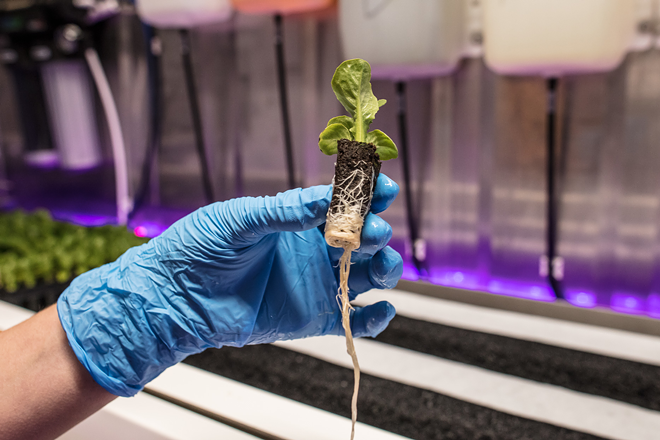
Another part of the plants' life cycle is spending six hours per day in the dark, giving them time to rest, regenerate and absorb nutrients. Greens gotta sleep, too, ya know.
"Because we can make night day and day night, we're running their daytime during the night because electricity is cheaper, and it's more energy efficient," Doyle says. "That's [another] reason we can go from seed to harvest in about six or seven weeks instead of about eight or nine. In Florida, or anywhere in the States for that matter, you only get about, maximum, 12 hours of sunlight a day. We get 18."
They're ready to be transplanted into a tower when their roots have "a nice curlicue at the bottom" and two sets of true leaves. If a crop's head is small, like that of Breen mini romaine, the farm can fit 16 plants on a tower; with fuller heads, a tower can comfortably grow six.
In Farm 1, which has a sweet scent and can be as cold as 60 degrees, there's Red Cross Butterhead, Rex lettuce (an ideal hydroponic similar to butterhead), heirloom Vulcan lettuce (for all you Star Trek fans) and arugula, to name a few. Greens that like it about 3 to 6 degrees warmer — think green and purple kales and basils, or long-and-spiny Toscano Italian kale (meant to be treated like spinach in the kitchen) — are born in the acidic-smelling Farm 3, just two containers down. These plants take in around 50 percent more nutrients than the lettuces.
Alongside some of the lesser-known varieties, the farm also creates its own spring mixes, alternatives to a standard bag of Costco or Publix spring mix. Doyle and O'Malley don't shy away from experimentation, either. They're playing with a multicolor ice lettuce appropriately dubbed "ice plant" because it always looks wet, and like it's donning little crystals.
The lineup of what’s growing will always spotlight basics, romaines and collards among them, with some unconventional finds rotated through to switch it up. Harvest can take place three to four times a week.
“We harvest on demand. It’s one of the benefits of being so local,” O’Malley says. “But most produce, especially greens that we have in Florida, are brought in from the west coast and southern California, so by the time it reaches us, it’s already seven to 10 days old. We’re harvesting within hours of delivery or pickup.”
Restaurants and chefs are their main distribution channels. Love Food Central is now working with Brick Street, and the owners hope to keep ‘em coming. They’ve reached out to locals such as Ciccio Restaurant Group, the cafe at Rollin’ Oats and Urban Restaurants Group. O’Malley says the Urbans have started expanding into bowls and salads, and that they’re interested in the collards, which have been in high demand. The Ciccio crew dug the kales and lettuces, too, though nothing has been finalized.

On its website, the farm’s gearing up to spotlight bags of choose-your-own greens — plus small (six heads) and large (between 12 and 15 heads) bags filled with what will essentially be a farmer’s choice mix — for those who want to place online orders. Open farm hours are coming to accommodate pick-up orders and educational tours for small groups three days a week. And the couple also want to have a presence at more local markets; Brick Street will make its debut to St. Pete Beach’s Corey Avenue Sunday Market on Nov. 20.
Although the technology allows them to monitor the farm remotely via an app that controls the lights, temperature, humidity and nutrients (just like the touch-screen Agrotech interface, or the “brain of the system,” does inside the containers), their goal is to be on-site full time.
And about those expansion plans: O’Malley and Doyle aim to dedicate half the property to their containers, which they’ll happily stack if necessary. The idea is to eventually go from vertical to horizontal growing, adding produce such as tomatoes, cucumbers and peppers to the product line. Ultimately looking to grow into their new home, they’re also working with an architect to develop a neighborhood event space, for gatherings with area chefs and city farm dinners featuring their food, on the other half.
Brick Street wants to bring the local food movement — a la Brooklyn and the rest — firmly to St. Pete. With a booming restaurant scene, tourist season picking up and a community that’s no stranger to supporting local, O’Malley says she thinks the city’s ready for it.
“I’ve noticed all generations are interested in it. It’s not just the millennials. It’s not just the 30-somethings. Folks really are looking to get away from the traditional model,” she says. “And it’s funny, knowing where your food comes from is not this radical idea. It’s just we’ve gotten so far away from it. People aren’t used to being able to see it and touch it.”
Now they can.
“For all these restaurants up and down Central Avenue and into downtown,” Doyle says, “it’s not any more local than literally less than a mile away.”
